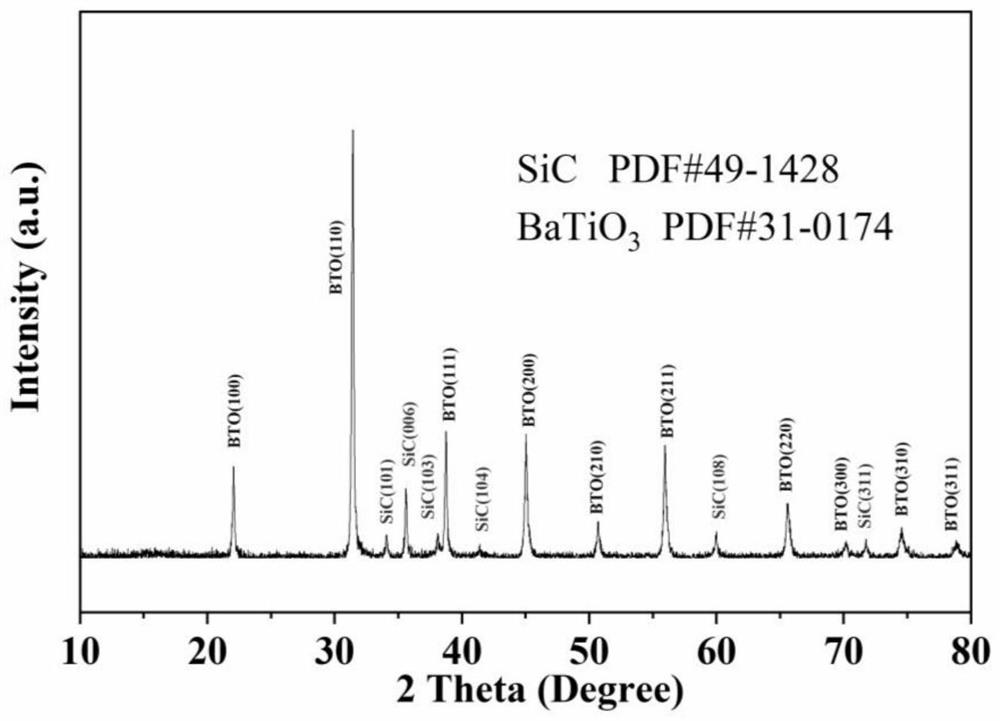A high-temperature-resistant ferroelectric polymer-based dielectric energy storage composite film and its preparation method and application
A technology of ferroelectric polymers and composite thin films, applied in the direction of thin film/thick film capacitors, fixed capacitor dielectrics, laminated capacitors, etc., can solve the problems of unmentioned high temperature applications, untested energy storage density and energy storage efficiency, etc. Achieve the effects of promoting self-assembly deposition, enhancing thermal conductivity, and improving thermal stability
- Summary
- Abstract
- Description
- Claims
- Application Information
AI Technical Summary
Problems solved by technology
Method used
Image
Examples
Embodiment 1
[0059] The high temperature resistant ferroelectric polymer-based dielectric energy storage composite thin film of this embodiment and the preparation method thereof comprise the following steps:
[0060] Step 1, weigh 1.6g of silicon carbide and dissolve it in a mixed solvent of 200ml of n-butanol, 10ml of deionized water, and 0.5g of cetyltrimethylammonium bromide, and ultrasonically disperse for 30min until a uniform suspension liquid A is formed. Then 4.39ml of tetrabutyl titanate was dissolved in 50ml of n-butanol, and magnetically stirred for 30min to form titanium dioxide precursor solution B.
[0061] Step 2, under the condition of magnetic stirring, slowly drop liquid B into liquid A for 12 hours, so as to completely hydrolyze tetrabutyl titanate. Composite powder can be obtained by spontaneous precipitation, washed three times with deionized water, and dried at 90°C.
[0062] Step 3, adding the obtained core-shell particles into a hydrothermal kettle together with a...
Embodiment 2
[0071] This embodiment is basically the same as Embodiment 1, the difference is:
[0072] Step 4, weigh 0.1132g of core-shell powder and disperse it into 10ml of dimethylformamide, and ultrasonically disperse for at least 4 hours until a uniform suspension is formed. Then 1.0193 g of P(VDF-HFP) was added to the suspension using ultrasonic dispersion and mechanical shaking for several hours until a homogeneous suspension. A composite film with a mass fraction of 10 wt.% was prepared by casting method. Dry at 90°C to obtain a nanocomposite film. The composite film is a single layer with a thickness of 10-20 μm.
Embodiment 3
[0074] This embodiment is basically the same as Embodiment 1, the difference is:
[0075] Step 4, weigh 0.0256g of core-shell powder and disperse it into 10ml of dimethylformamide, and ultrasonically disperse for at least 4 hours until a uniform suspension is formed. Then 0.9998 g of P(VDF-HFP) was added to the suspension using ultrasonic dispersion and mechanical shaking for several hours until a homogeneous suspension. A composite membrane with a core-shell nanofiller mass fraction of 2.5wt.% was prepared by casting method. Dry at 90°C to obtain a nanocomposite film. The composite film is a single layer with a thickness of 10-20 μm.
PUM
| Property | Measurement | Unit |
|---|---|---|
| particle diameter | aaaaa | aaaaa |
| particle diameter | aaaaa | aaaaa |
| thickness | aaaaa | aaaaa |
Abstract
Description
Claims
Application Information
 Login to View More
Login to View More - R&D
- Intellectual Property
- Life Sciences
- Materials
- Tech Scout
- Unparalleled Data Quality
- Higher Quality Content
- 60% Fewer Hallucinations
Browse by: Latest US Patents, China's latest patents, Technical Efficacy Thesaurus, Application Domain, Technology Topic, Popular Technical Reports.
© 2025 PatSnap. All rights reserved.Legal|Privacy policy|Modern Slavery Act Transparency Statement|Sitemap|About US| Contact US: help@patsnap.com



